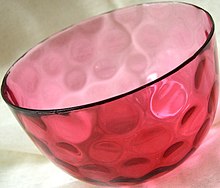Richard Adolf Zsigmondy
Richard Adolf Zsigmondy | |
|---|---|
| Doctoral advisor | Wilhelm von Miller |
Richard Adolf Zsigmondy (
Biography
Early years
Zsigmondy was born in
He began his academic career at the
Career
In 1885 Zsigmondy published his very first article as a joint publication with his Viennese professor
In July 1892 Zsigmondy held a colloquium at
Zsigmondy left Schott Glass in 1900, but remained in Jena as private lecturer to conduct his research. Together with the optical instrument manufacturer
Before Zsigmondy finished his PhD thesis in organic chemistry, he published research on colouring glass with

During his stay in Graz, Zsigmondy accomplished his most notable research work, on the chemistry of

In later years he worked on gold hydrosols and used them to characterize protein solutions. While in Jena he developed the slit ultramicroscope together with Henry Siedentopf. After moving to Göttingen, Zsigmondy improved his optical equipment for the observation of finest nanoparticles suspended in liquid solution. As a result, he introduced the immersion ultramicroscope in 1912.[8]
Together with Wilhelm Bachmann, Zsigmondy developed a new membrane filter (1916).[9] He later transferred his patents to a company established by him, other shareholders and Sartorius AG which was incorporated to Sartorius in the late 1970s.[10][11]
Private life

In 1903 Zsigmondy married Laura Luise Müller, with whom he had two daughters, Annemarie and Käthe.
Richard Zsigmondy died due to his arteriosclerosis only a few months after retiring from his university position in Göttingen in early March.[12][4][13]
He was a cousin of the architect Frigyes Schulek, whose mother was Auguszta Zsigmondy. He is also related to the violinist Dénes Zsigmondy.
Ancestry
| Richard Zsigmondy, Vienna (A) 1862–Göttingen (D) 1929 scientist, Nobel Prize Winner in chemistry 1925 |
Father: Adolf Zsigmondy Pressburg/ Pozsony , (HUN) 1816–Vienna (A) 1880 |
Grandfather: Sámuel Zsigmondy Pilis, (HUN) 1788– 1833 Pressburg/ Pozsony (HUN) |
Great-grandfather: G. Zsigmondy Körmöcbánya (HUN) 1748-Pilis (HUN) 1799
|
Great-great-grandfather: J. Zsigmondy Körmöcbánya (HUN) 1765
|
Great-great-grandmother: Zsuzsanna Kossovits Besztercebánya (HUN) ? (HUN) 1790
-Lónyabánya |
| Great-grandmother: Judit Polereczky Alberti (Now Albertirsa) (HUN) 1756– 1833 Pressburg/Pozsony (HUN) | |||||
| Grandmother: Friderika Fábry 1793 Pressburg/ Pozsony (HUN)– 1868 Pressburg/Pozsony (HUN) |
grandmother's father: István Fábry Hrussó (HUN) 1751 – Pressburg/ Pozsony (HUN) 1817 | ||||
| grandmother's mother: Terézia Bayer | |||||
| Mother: Irma von Szakmáry Martonvásár (HUN) 1835 Vienna 1900 |
Mothers father: N.N. von Szakmáry (1818– 1888) |
Mother's grandfather : | |||
| N.N.: | |||||
| Mothers mother: Mária Gegus von Kisgessény ? 1800 Pressburg/ Pozsony (HUN) 18 September 1883[15] |
N.N. : Sámuel Gegus | ||||
| NN: ' |
Honours
- Nobel Prize in Chemistry (1925, awarded in 1926)[1]
- Member of the Göttingen Academy of Sciences and Humanities, Göttingen (since 1914)[4]
- Corresponding member of the Academia de Ciencias de Zaragoza,[16][17] the Austrian Academy of Sciences and academies/academic societies in Valencia and Harlem.[12]
- Honorary doctorates of TU Wien (1917),[18] Graz University of Technology (1928),[19] and the medical faculty of the University of Königsberg.[12]
Selected publications
- .
- Zsigmondy, R.(1887). "Neue Lüster und Farben auf Glas". Polytechnisches Journal. 266: 364–370.
- LCCN tmp84012343.
- .
- .
- .
- OL 1473920W.
- Zsigmondy, R.(1907). Über Kolloid-Chemie mit besonderer Berücksichtigung der anorganischen Kolloide. Leipzig: Johann Ambrosius Barth.
- LCCN 09012628.
- LCCN 12018021.
- .
- S2CID 97752413.
- LCCN 17029221.
See also
References
- ^ a b c "Richard Zsigmondy - Biographical". nobelprize.org. Retrieved 2022-10-08.
- .
- ^ a b Herbert Freundlich (1930). "RICHARD ZSIGMONDY (1865-1929)" (PDF). Berichte der Deutschen Chemischen Gesellschaft. 63 (11): 171–175.
- ^ a b c Monique Zimon. "Die Göttinger Nobelpreisträger" (PDF). gwdg.de (in German). Retrieved 2022-10-08.
- ISBN 3-205-98910-4.
- ISBN 3-205-98910-4.
- .
- PMID 23065955.
- ^ U.S. patent 1421341A
- ^ "Filtrationsgerät, Beschreibung in English". uni-goettingen.de. Retrieved 2022-10-08.
- ^ "Richard Zsigmondy and the Origins of Sartorius Filtration Technology". sartorius.com. Retrieved 2022-10-08.
- ^ a b c "Zsigmondy, Richard Adolf". austria-forum.org. Retrieved 2022-09-29.
- ^ "Professor Richard Zsigmondy (in Neues Wiener Tagblatt), page 10". onb.ac.at (in German). Retrieved 2022-10-08.
- ISBN 963-09-3569-4
- ^ "National Séchenyi Library - Funeral notices - Irma von Szakmáry geb. Gegus obituary".
- ^ Pedro J. Miana. "Jacques Hadamard en Zaragoza" (PDF). unizar.es (in Spanish). Retrieved 2022-10-05.
- ^ Academia de Ciencias de Zaragoza: Un siglo de servicio a la sociedad (in Spanish). January 2016. Retrieved 2022-10-05 – via academia.edu.
- ^ "Honory [sic] doctorates". tuwien.at. Retrieved 2022-09-20.
- ^ "Grazer Tagblatt Samstag, 6. Oktober 1928, page 5". onb.ac.at (in German). Retrieved 2022-09-20.
Further reading
- J. Reitstötter (1966). "Richard Zsigmondy". Kolloid-Zeitschrift und Zeitschrift für Polymere. 211 (1–2): 6–7. S2CID 197929544.
- "R. Zsigmondy (1865–1929)". Nature. 206 (4980): 139. 1965. S2CID 2466716.
- Lottermoser (1929). "Richard Zsigmondy zum Gedächtnis". Zeitschrift für Angewandte Chemie. 42 (46): 1069–1070. .
- "Richard Zsigmondy zum 60. Geburtstage". Zeitschrift für Angewandte Chemie. 38 (14): 289. 1925. .
- H. Freundlich (1930). "Richard Zsigmondy zum 60. Geburtstage". Berichte der Deutschen Chemischen Gesellschaft. 63 (11): A171–A175. .
External links
- Richard Adolf Zsigmondy on Nobelprize.org including the Nobel Lecture, December 11, 1926 Properties of Colloids
- Mappes, Timo (2012). "Immersionsultramikroskop nach R. Zsigmondy von Winkel-Zeiss, Göttingen". Immersion ultramicroscope with optics as of the 1912 patent. Retrieved 2012-11-02.

